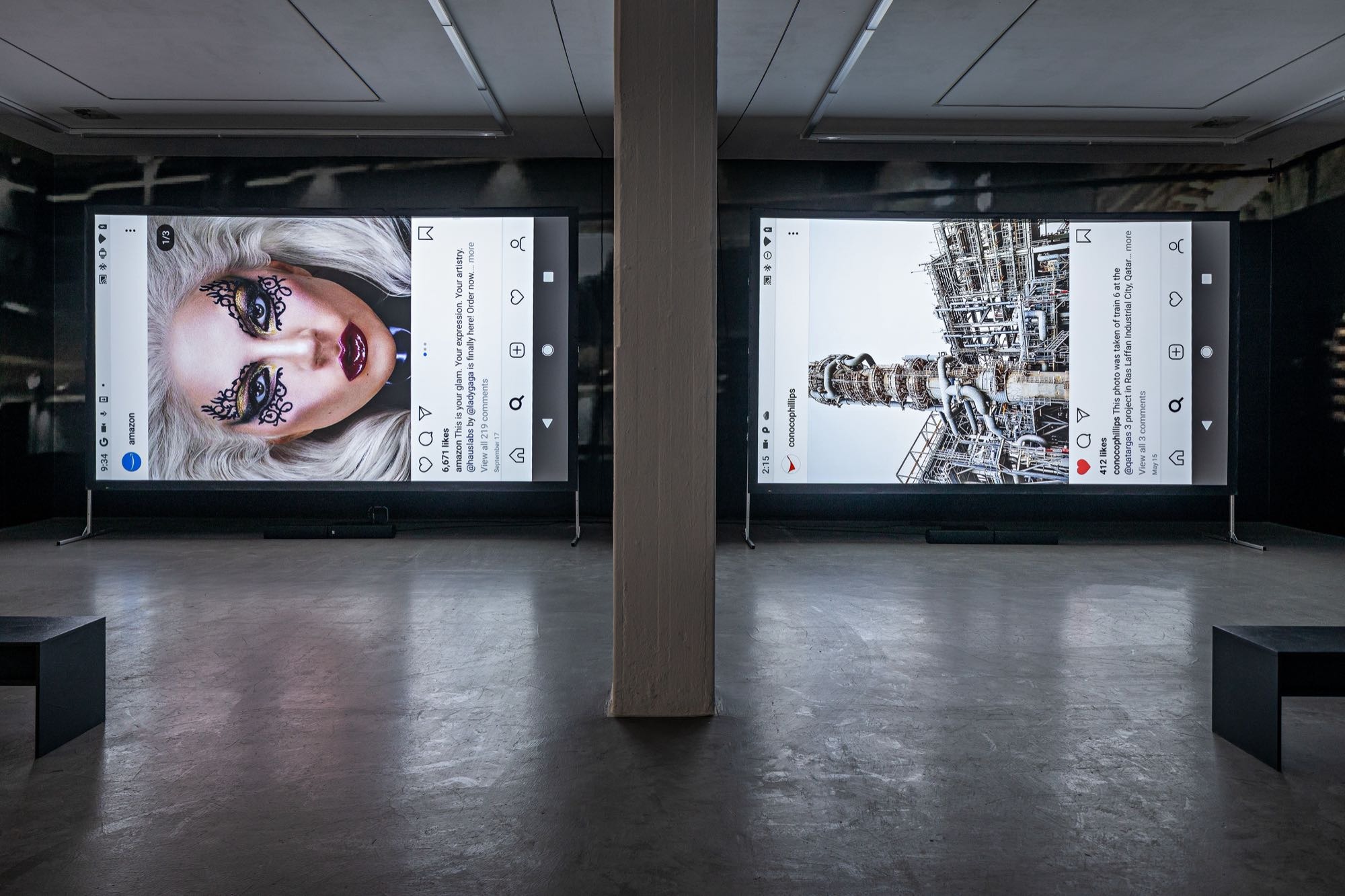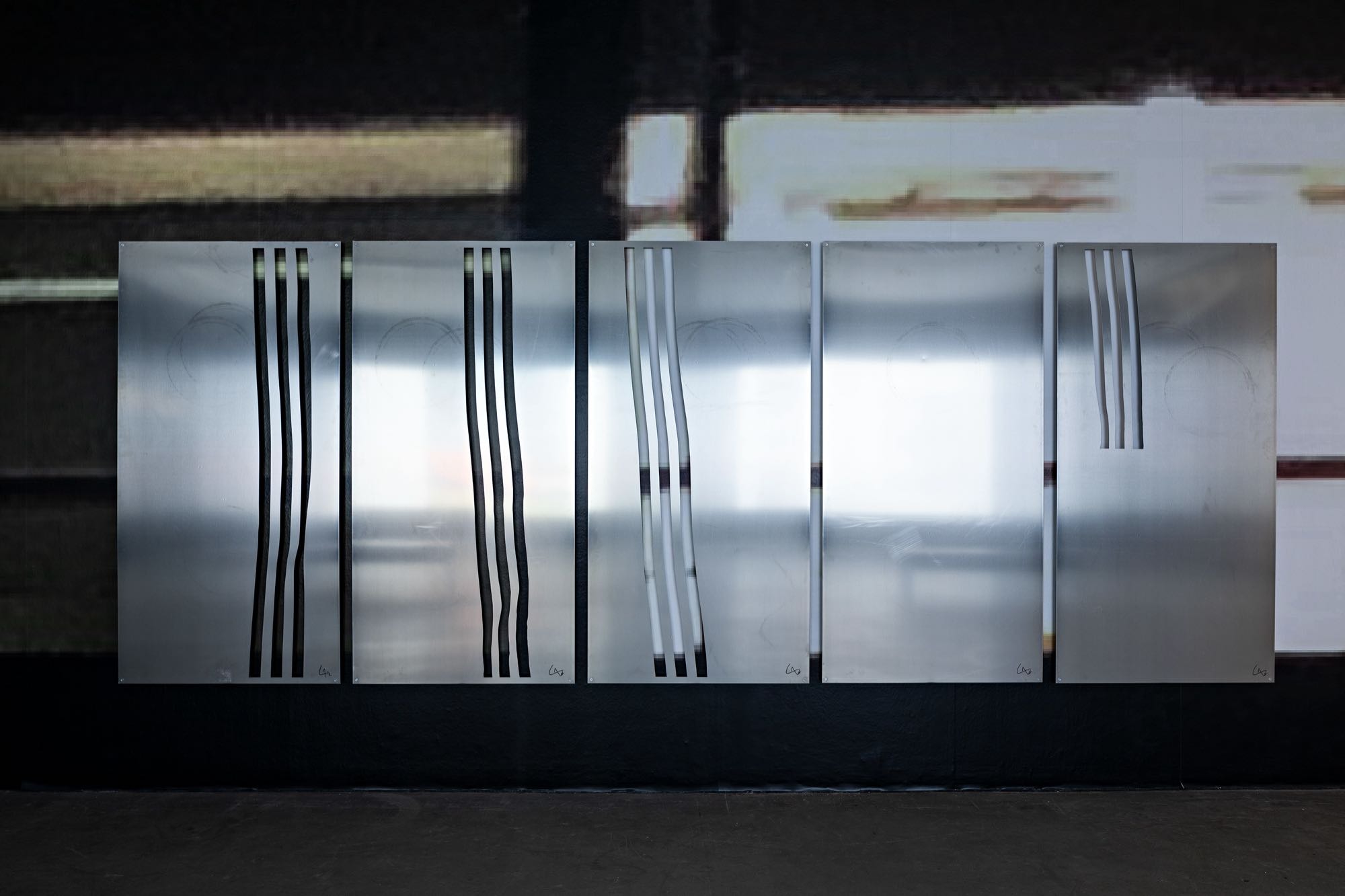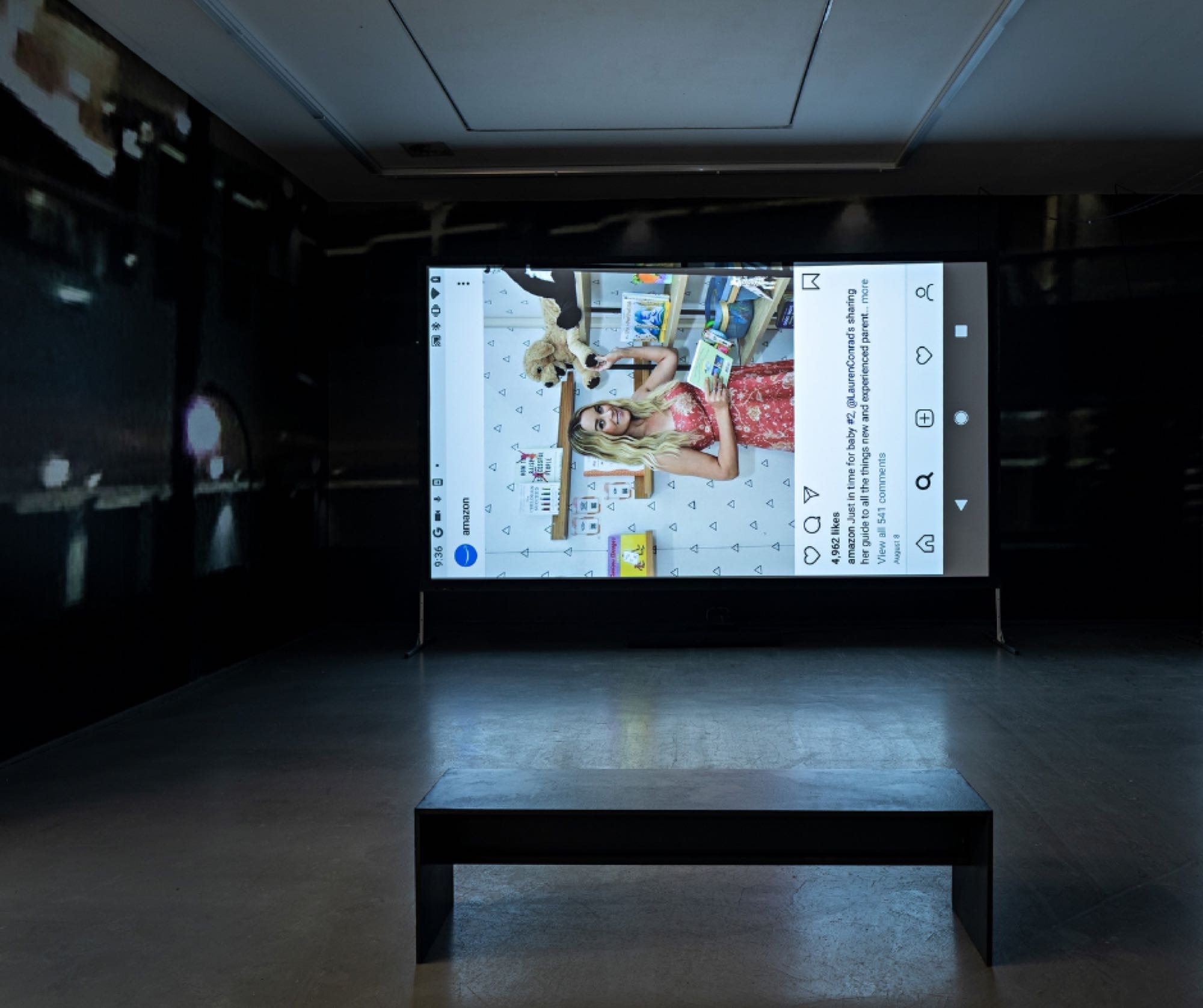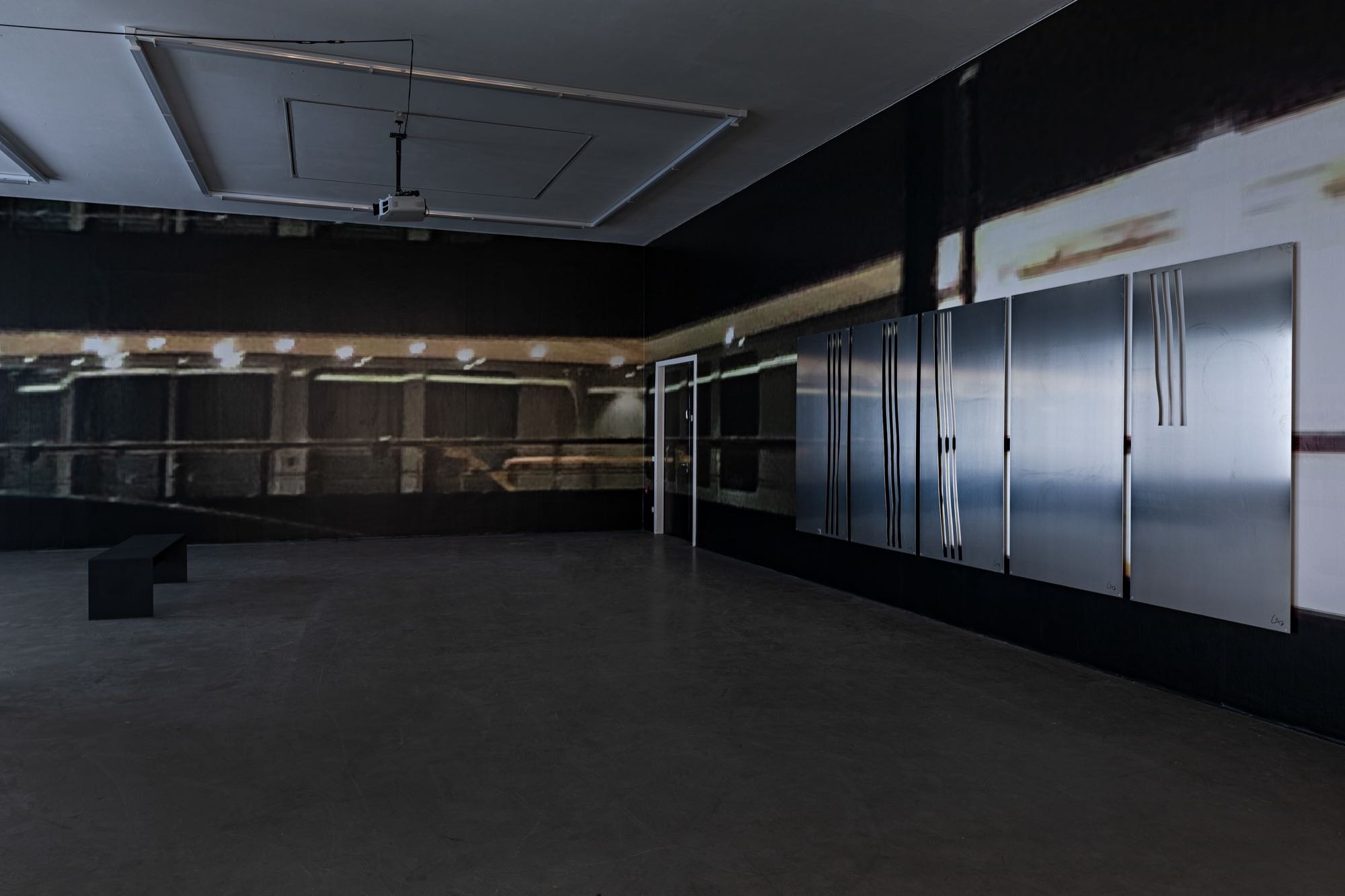Cory Arcangel
Flying Foxes
12 Nov 2022 - 12 Feb 2023
Cory Arcangel (*1978 Buffalo, New York, lives in Stavanger, Norway) is a central figure in a generation of artists responsive
to recent technical developments in an increasingly information-saturated global culture. Arcangel’s postconceptual practice has approached forms such as Photoshop gradients, video game modifications, and YouTube tutorials to produce works of art that deal with the inextricable link between digital technology and today’s popular culture. Part of Arcangel’s interest in these current trends is their rapid obsolescence, structurally built into their material—their programming, codes, and hardware. As such, Arcangel’s work deals with the confluence of digital technologies across time, how we experience them aesthetically and by their nature, how they determine such an experience.
For the exhibition at the Kunstverein in Hamburg, Arcangel brings together several recent works in response to the legacy of Michel Majerus. The exhibition takes its title from Flying Fox, a 136 meter mega-yacht photographed by Arcangel in the port
of Stavanger and whose ownership is shrouded in mystery. By reproducing this image as a large-scale wallpaper wrap, Arcangel sets the scene for a group of works which conflate the free-floating transmission of images and their consumption online with the life of global resources—from extraction to their circulation as the assets of the global 0.1%.
While a photograph of a 136-meter yacht taken with an iPhone 8 may not be the first thing that comes to mind when
thinking of digital assets, this yacht, or the image of it, appears for Arcangel as an indication to how such physical assets
are inextricably tied to the new class of wealth resultant from the inventions of Web 2.0 (think of the protagonists of Amazon & Co.). It also indicates, just like the uneasy waters of international seafaring, to how wealth on the Internet is unmoored from national or communal interests. Arcangel’s exhibition at the Kunstverein in Hamburg started with this image taken at the port of Stavanger (where the artist lives) in 2019, a port which serves as a first point of call for many megayachts such as the Flying Fox, providing a tax loophole that excludes payment of VAT after their construction by companies such as Lürssen, based in Northern Germany. Associated with international billionaires and oligarchs, yachts such as the Flying Fox are synonymous with a concentration of both wealth and leisure. For example, although most associated since 2019 with Jeff Bezos, it was also Beyoncé as well as Jay Z who have appeared on the yacht (reportedly at a rate of €3 million a week), a New York Times article published on October 23rd, 2022, “Russian Superyachts Find Safe Haven in Turkey, Raising Concerns in Washington’’ revealed the yacht was recently listed as a “blocked property” by the US Treasury, and its management company, Imperial Yachts, was also sanctioned.
For this exhibition, Arcangel transposes this connection between Stavanger and the Hamburg region onto the
architecture of the Kunstverein by stretching the photograph to fit its mode of exhibition. For Arcangel, there is no native output for this image, rather, it is stretched “lifesize”, and then cropped to fit any media in which it is distributed—for instance, the seemingly abstracted 7x7pixel images on the Kunstverein website and social media show a 7x7cm section of the yacht, sized for today’s most popular cell phone in the “Northwest”, the iPhone 14. These outputs precede Arcangel’s current development of a not yet publicly available NonFungible Token (NFT) representing mega-yachts, developed with NFT platform Folia. In these various outcomes, Arcangel’s distributed artwork performs a variety ofs forms of assets in galleries, on servers, or from the screen of a cell phone. It playfully implies the tension of access and exclusion that are apparent with a yacht or an art institution or a digital wallet, and the ways in which each share basic economic relations. This infers the broader subjet of Arcangel’s work, which vies with the technologically mediated structures that govern our perceptions of reality, or in Arcangel’s words: as an artist he is “a specialist in things that people don’t pay attention to”. Since early in his career, Arcangel has dealt with hacking Nintendo cartridges or using Photoshop gradients as readymades. Meanwhile, his approach to producing art embraces the itinerant or peripatetic play of Internet surfing as a cultural phenomenon—an approach to media that is analogous to the seemingly contradictory behaviours of consumer browsing, online research, and hacking. Such an approach conflates what is often called “research-based practice” with the enjoyment and leisure of spending time online. Not only points
this to the motivational desire inherent to his research, but situates Arcangel’s artistic practice within the prosaic user behaviour that we often do not notice ourselves taking part in.
Yet while we might consider Arcangel an Internet surfer (he is an admitted Are.na power user), it is a fact that Internet surfing has profoundly transformed since the developments of Web 2.0. Today, the way in which the Internet is visible to and navigated by most users is through a handful of platforms that channel Internet traffic, and by extension, the attention of users—Google, Facebook, Weibo. In this “attention economy”, the grasp on users is considered a valuable resource, and platforms are increasingly designed to extract meta-data on users’ interests while at the same time marketing new products and experiences. It is, in short, a cyclical movement of consumer behaviour that is selfreproducing while attempting to keep you online just a bit
longer. This forecasts the further spread and mobilisation of the “Internet of things”, where physical objects (fridges, cars,
security systems, bodies) act as points of data collection and exchange. Arcangel’s use of the NFT as a medium however
also suggests the promise of blockchain enthusiasts who see the development of Web3 as a means to decentralise data, returning some of the power of the Internet back in the hands of the user.
The series of video works Runners document the performance of such user behaviour via the use of a bot designed by the artist and his studio. The two Runners on view in this exhibition are entitled and Disclaimer (both 2019), showing the Instagram profiles of web-retail giant Amazon and American oil company ConocoPhillips respectively. Scrolling the profiles of these corporations and programmed to “liking” each post, the automated viewership of the bot produces a form of corporate portraiture at its most prosaic level of public relations. Screen-recorded with a smartphone, the format of these videos has been turned horizontal to give the impression of a minimalist film that tracks from left to right instead of required scrolling down—a technique reminiscent of Arcangel’s video-game hack Super Mario Clouds (2002). While its recording recalls Dziga Vertov’s famous phrase ventriloquising the camera —“I’m an eye. A mechanical eye. I, the machine, show you a world the way only I can see it.”— the revelation of Arcangel’s Runners only shows a certain entropy associated with the pervasiveness of advertising. British theorist Mark Fisher has called this condition “Capitalist Realism”, thus anticipating the behavioural entrapment that Millenials and Zoomers were inspired to ironically call “Doom Scrolling”.
Arcangel’s large aluminium wall works titled 3-, and - (2022) match these films. These works perform the status of painting
and recall the multi-panelled works of Barnett Newman while inhabiting the material of a superyacht. The “zips” (vertical
stripes) that Newman famously referred to as spatially orienting the viewer within the canvas’ frame are rather laser cut forms derived from vectors abstracted from images of Adidas tracksuits. The comfortable air of the leisure-suit is here rendered in aluminum, the notion of the canvas converted to the most practical of unfinished surfaces (easily buffed or repolished), and the artist’s hand almost completely removed from the process of production. Still, the iconic 3-stripe branding of the German sports company is easily recognisable, even when reduced to the simplest vectorised form. Following the Runners, these works perform corporate branding as a state of near exhaustion.
For the viewer, consumer, or user, Arcangel’s work flirts with the entropy of consumerism. This cynical emptiness is most apparent in the (PE) works, consisting of “grab-andgo snacking” sandwich bags thermally laminated into A4 plastic sheets, and by extension, awarded the aura of art. Like much of the work in this exhibition, it considers a basic form (the zip-lock bag) as something with meanings beyond what is immediately perceivable through its use. These bags appear somewhere between evidence, readymade, and archaeological finding, reflective of the place that each interpretation silently inhabits in our reading of an object. Produced from petro-chemicals and inextricably linked to the consumption of food, they infer the relation between energy resources and their human expenditure. While the most discreet work in the exhibition, Arcangel’s preservation of
these bags hints to the impossibility of art to exist outside of the society in which it is made, while reflecting the conditions that put it into being. Arcangel’s work considers the artistas-user while pointing to the limits of navigating a field determined by the intersecting powers of technological and economic forces.
Curated by Nicholas Tammens
to recent technical developments in an increasingly information-saturated global culture. Arcangel’s postconceptual practice has approached forms such as Photoshop gradients, video game modifications, and YouTube tutorials to produce works of art that deal with the inextricable link between digital technology and today’s popular culture. Part of Arcangel’s interest in these current trends is their rapid obsolescence, structurally built into their material—their programming, codes, and hardware. As such, Arcangel’s work deals with the confluence of digital technologies across time, how we experience them aesthetically and by their nature, how they determine such an experience.
For the exhibition at the Kunstverein in Hamburg, Arcangel brings together several recent works in response to the legacy of Michel Majerus. The exhibition takes its title from Flying Fox, a 136 meter mega-yacht photographed by Arcangel in the port
of Stavanger and whose ownership is shrouded in mystery. By reproducing this image as a large-scale wallpaper wrap, Arcangel sets the scene for a group of works which conflate the free-floating transmission of images and their consumption online with the life of global resources—from extraction to their circulation as the assets of the global 0.1%.
While a photograph of a 136-meter yacht taken with an iPhone 8 may not be the first thing that comes to mind when
thinking of digital assets, this yacht, or the image of it, appears for Arcangel as an indication to how such physical assets
are inextricably tied to the new class of wealth resultant from the inventions of Web 2.0 (think of the protagonists of Amazon & Co.). It also indicates, just like the uneasy waters of international seafaring, to how wealth on the Internet is unmoored from national or communal interests. Arcangel’s exhibition at the Kunstverein in Hamburg started with this image taken at the port of Stavanger (where the artist lives) in 2019, a port which serves as a first point of call for many megayachts such as the Flying Fox, providing a tax loophole that excludes payment of VAT after their construction by companies such as Lürssen, based in Northern Germany. Associated with international billionaires and oligarchs, yachts such as the Flying Fox are synonymous with a concentration of both wealth and leisure. For example, although most associated since 2019 with Jeff Bezos, it was also Beyoncé as well as Jay Z who have appeared on the yacht (reportedly at a rate of €3 million a week), a New York Times article published on October 23rd, 2022, “Russian Superyachts Find Safe Haven in Turkey, Raising Concerns in Washington’’ revealed the yacht was recently listed as a “blocked property” by the US Treasury, and its management company, Imperial Yachts, was also sanctioned.
For this exhibition, Arcangel transposes this connection between Stavanger and the Hamburg region onto the
architecture of the Kunstverein by stretching the photograph to fit its mode of exhibition. For Arcangel, there is no native output for this image, rather, it is stretched “lifesize”, and then cropped to fit any media in which it is distributed—for instance, the seemingly abstracted 7x7pixel images on the Kunstverein website and social media show a 7x7cm section of the yacht, sized for today’s most popular cell phone in the “Northwest”, the iPhone 14. These outputs precede Arcangel’s current development of a not yet publicly available NonFungible Token (NFT) representing mega-yachts, developed with NFT platform Folia. In these various outcomes, Arcangel’s distributed artwork performs a variety ofs forms of assets in galleries, on servers, or from the screen of a cell phone. It playfully implies the tension of access and exclusion that are apparent with a yacht or an art institution or a digital wallet, and the ways in which each share basic economic relations. This infers the broader subjet of Arcangel’s work, which vies with the technologically mediated structures that govern our perceptions of reality, or in Arcangel’s words: as an artist he is “a specialist in things that people don’t pay attention to”. Since early in his career, Arcangel has dealt with hacking Nintendo cartridges or using Photoshop gradients as readymades. Meanwhile, his approach to producing art embraces the itinerant or peripatetic play of Internet surfing as a cultural phenomenon—an approach to media that is analogous to the seemingly contradictory behaviours of consumer browsing, online research, and hacking. Such an approach conflates what is often called “research-based practice” with the enjoyment and leisure of spending time online. Not only points
this to the motivational desire inherent to his research, but situates Arcangel’s artistic practice within the prosaic user behaviour that we often do not notice ourselves taking part in.
Yet while we might consider Arcangel an Internet surfer (he is an admitted Are.na power user), it is a fact that Internet surfing has profoundly transformed since the developments of Web 2.0. Today, the way in which the Internet is visible to and navigated by most users is through a handful of platforms that channel Internet traffic, and by extension, the attention of users—Google, Facebook, Weibo. In this “attention economy”, the grasp on users is considered a valuable resource, and platforms are increasingly designed to extract meta-data on users’ interests while at the same time marketing new products and experiences. It is, in short, a cyclical movement of consumer behaviour that is selfreproducing while attempting to keep you online just a bit
longer. This forecasts the further spread and mobilisation of the “Internet of things”, where physical objects (fridges, cars,
security systems, bodies) act as points of data collection and exchange. Arcangel’s use of the NFT as a medium however
also suggests the promise of blockchain enthusiasts who see the development of Web3 as a means to decentralise data, returning some of the power of the Internet back in the hands of the user.
The series of video works Runners document the performance of such user behaviour via the use of a bot designed by the artist and his studio. The two Runners on view in this exhibition are entitled and Disclaimer (both 2019), showing the Instagram profiles of web-retail giant Amazon and American oil company ConocoPhillips respectively. Scrolling the profiles of these corporations and programmed to “liking” each post, the automated viewership of the bot produces a form of corporate portraiture at its most prosaic level of public relations. Screen-recorded with a smartphone, the format of these videos has been turned horizontal to give the impression of a minimalist film that tracks from left to right instead of required scrolling down—a technique reminiscent of Arcangel’s video-game hack Super Mario Clouds (2002). While its recording recalls Dziga Vertov’s famous phrase ventriloquising the camera —“I’m an eye. A mechanical eye. I, the machine, show you a world the way only I can see it.”— the revelation of Arcangel’s Runners only shows a certain entropy associated with the pervasiveness of advertising. British theorist Mark Fisher has called this condition “Capitalist Realism”, thus anticipating the behavioural entrapment that Millenials and Zoomers were inspired to ironically call “Doom Scrolling”.
Arcangel’s large aluminium wall works titled 3-, and - (2022) match these films. These works perform the status of painting
and recall the multi-panelled works of Barnett Newman while inhabiting the material of a superyacht. The “zips” (vertical
stripes) that Newman famously referred to as spatially orienting the viewer within the canvas’ frame are rather laser cut forms derived from vectors abstracted from images of Adidas tracksuits. The comfortable air of the leisure-suit is here rendered in aluminum, the notion of the canvas converted to the most practical of unfinished surfaces (easily buffed or repolished), and the artist’s hand almost completely removed from the process of production. Still, the iconic 3-stripe branding of the German sports company is easily recognisable, even when reduced to the simplest vectorised form. Following the Runners, these works perform corporate branding as a state of near exhaustion.
For the viewer, consumer, or user, Arcangel’s work flirts with the entropy of consumerism. This cynical emptiness is most apparent in the (PE) works, consisting of “grab-andgo snacking” sandwich bags thermally laminated into A4 plastic sheets, and by extension, awarded the aura of art. Like much of the work in this exhibition, it considers a basic form (the zip-lock bag) as something with meanings beyond what is immediately perceivable through its use. These bags appear somewhere between evidence, readymade, and archaeological finding, reflective of the place that each interpretation silently inhabits in our reading of an object. Produced from petro-chemicals and inextricably linked to the consumption of food, they infer the relation between energy resources and their human expenditure. While the most discreet work in the exhibition, Arcangel’s preservation of
these bags hints to the impossibility of art to exist outside of the society in which it is made, while reflecting the conditions that put it into being. Arcangel’s work considers the artistas-user while pointing to the limits of navigating a field determined by the intersecting powers of technological and economic forces.
Curated by Nicholas Tammens




